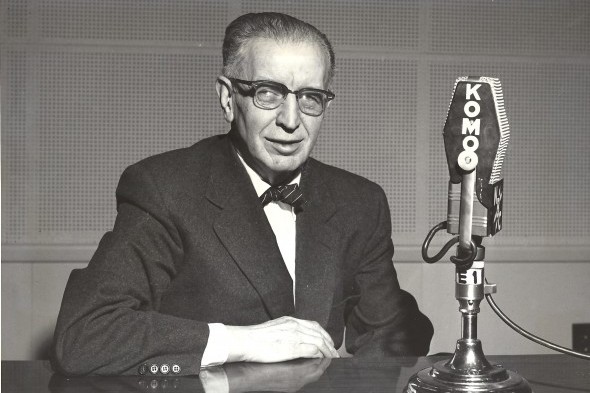
By David Eskenazi and Steve Rudman
Years ago, in May 1971 as near as we can figure, August Augie Navarro, the radio voice of the Pacific Coast Leagues Salt Lake City Angels and a former catcher for Ogden, Boise and Twin Falls in the old Pioneer League (1939-41), settled into a small studio located off an alley in the Utah capital and prepared to broadcast almost live — an Angels road game against the Eugene Emeralds.
Augie, who favored Hawaiian shirts, would not actually watch the game. Instead, he would re-create it using cryptic Western Union transmissions and all the imagination at his command. Most of Augies listeners would swear his voice came to them from Civic Stadium, home of the Ems, as headline writers usually referred to the Emeralds.
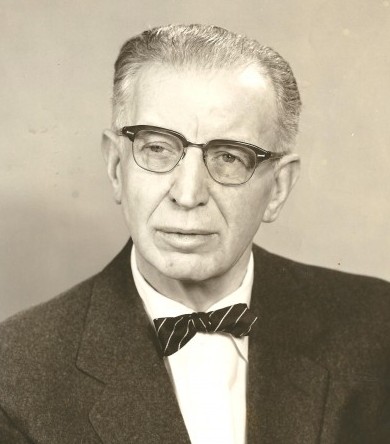
An old Salt Lake Tribune newspaper clipping mentioned that Augie, whom many fans called “Augie Doggie” because of a Hanna-Barbera cartoon titled “Quick Draw McGraw,” which also featured Augie’s sidekick, “Doggie Daddie,” had at his disposal a control panel that provided him access to the stations sound-effects library. Augie “Doggie” could push a button and listeners would hear a recording of continuous, general crowd noise. Augie ran this tape throughout his re-creation.
He could hit other buttons and listeners would hear wild cheering or boos and hisses. He played those tapes to correspond to actual developments in the game.
Augie “Doggie” had additional methods of dressing up the re-creation of a game he would not see. From the special-effects library, he could play tapes of ballpark vendors yelling in the background, Ice-cold beer here! and Get your red-hot peanuts!
The Tribune clipping also noted that Augie suspended a baseball bat from the studio ceiling. When a batter made contact, Augie struck the bat with a ruler to duplicate the sound of a ball hitting a bat (some re-creators tapped a drumstick on a wooden block to get the same effect). If an Emerald batter got a hit, Augie quickly called up the applause/cheering tape. But if an Angel got a hit, Augie played his boo/hiss tape.
Augie also kept a catchers mitt nearby so that he could pound a baseball into it, replicating the sound of a ball thumping into a glove.
According to a story told years ago by Rod Belcher, one of the great sportscasters in Puget Sound history, Rollie Truitt, long-time voice of the Portland Beavers, a contemporary of Augies, and an expert re-creator himself, once slapped his hand against his thigh to approximate the sound of a ball smacking a mitt, and succeeded only in lighting a book of matches in his pocket.
Augie also had a smaller speaker located behind his studio seat. Through the use of a separate microphone, Augie could say, Now at bat is . . . and make listeners believe they had just heard the stadiums PA announcer.
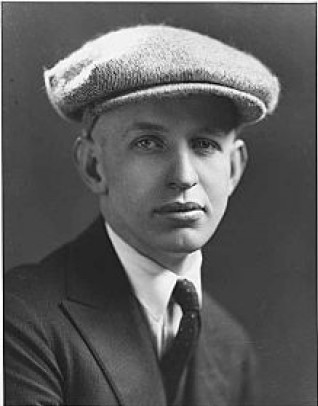
Augie typically started his re-creation 15-to-30 minutes after the real game got underway, which was about the time Western Union dispatches began arriving in his studio. The procedure, for the Salt Lake-Eugene game, went this way:
A Western Union teletype operator at the ballpark in Eugene tapped on his machine, streaming tiny bits of play-by-play data to Augie. Thirty years earlier, when re-creations were new, Augie would have received such info in Morse Code, necessitating the need for another Western Union operator in Augies studio to translate the dots and dashes.
But by the time of this particular Salt Lake City-Emerald game, Augie received a series of simplified scripts of a kind best described by Belcher, himself a master of re-creations, in a 1979 Seattle Times magazine story on the art of baseball re-creations.
“Seattle third. Smith up, bats right. S 1 C (strike one, called) — S 2 Foul — B 1 low — Hit — Smith singles to left.
Jones up, bats left. S 1 S (strike one, swinging) OUT Jones flies to center, Smith holds first.
From that paucity of detail, but aided by sound effects, his knowledge of baseball and the ballpark, his familiarity with players and managers, and his sheer ingenuity, Augie, and others of his ilk, could make a listener believe a broadcast emanated live from the ballpark.
A re-creators imagination came in especially handy when snafus developed. Occasionally, Western Union experienced transmission problems, in which case the re-creator might invent a catchers visit to the pitchers mound, or a mound conference, or extra foul balls by a batter, or slow work by the pitcher.
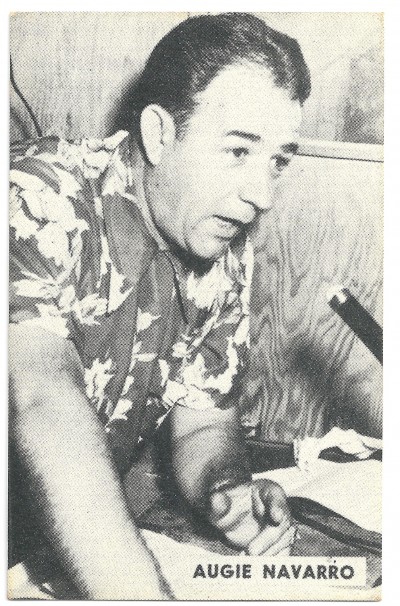
A re-creator might further conjure up a fight in the stands, a rhubarb on the field, or a technical ballpark malfunction — anything to stall for time. If the Western Union interruption lasted for any length of time, a quick-thinking re-creator (they all had to be quick thinkers) might tell stories or read ad copy. In extreme cases, the re-creator might invent a rain delay.
Baseball re-creations began in the 1930s, were standard industry fare through the 1960s, but were coming to an end by the time Augie “Doggie’ Navarro re-created the Salt Lake-Emerald game. Radio stations used re-creations since they eliminated the cost of traveling an announcer and the significant expense of purchasing broadcast phone lines from distant ballparks.
Most of the Pacific Northwests legendary broadcast figures launched their careers doing re-creations, not only of baseball games, but football and basketball as well. The pantheon of re-creators includes Belcher, Bob Robertson, Bill Schonley and the late Bob Blackburn.
No one, of course, did them quite like Leo Lassen, notable among the re-creators of his era not only for the high drama attendant to his accounts, but for his refusal to embellish his re-creations with sound effects.
Lassens legendary adherence to accuracy and detail, his encyclopedia knowledge of baseball, and his insistence on sticking precisely to the Western Union scripts only begins to explain his popularity over so many years (1931-60) as the voice of the Indians and Rainiers.
Born Leo H. Lassen in Marathon County, WI., July 5, 1899, to German immigrant parents (his mothers name was Minnie, his fathers never appeared in any story about Leo), Lassen moved to Seattle with his parents and two older brothers when he was a child. He arrived, according to newspaper accounts, with a crooked left arm, the result of a sidewalk spill.
The Lassen family originally occupied a house on the corner of Rainier Avenue S and Alaska Street (the structure ultimately became a funeral home) and subsequently moved to the Wallingford neighborhood north of Seattle. Lassen attended Lincoln High School, where he tried out for the baseball team, but wasnt good enough to make it (crooked arm couldnt have helped).
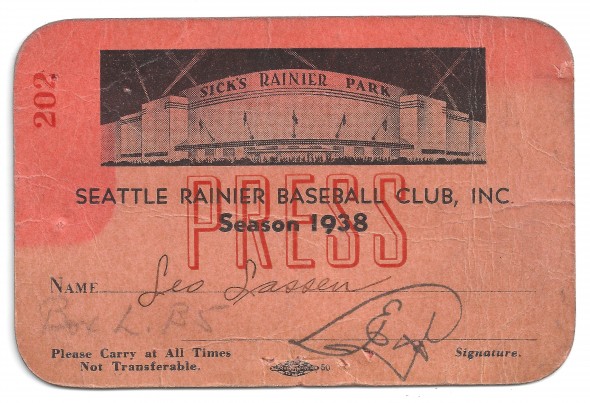
Following his 1917 graduation, Lassen went to work at The Seattle Post-Intelligencer as a copy boy, joining another soon-to-be famous young buck, Royal Brougham, and in 1918 found employment as a reporter for the long-gone Seattle Star (1899-47), where he rose to sports editor in 1919 and managing editor in 1928.
In 1930, America in the grip of the Great Depression, The Star pink slipped Lassen and other staffers in a cost-cutting measure. Lassen eventually found work with Seattles International News Service bureau and became a part-time publicist, landing as one of his first clients the Seattle Indians of the Pacific Coast League.
Lassens relationship with team changed a year later when the Indians found themselves in the market for a play-by-play voice after Ken Stuart Sr., one of the Northwests radio pioneers, left the club without a word of explanation.
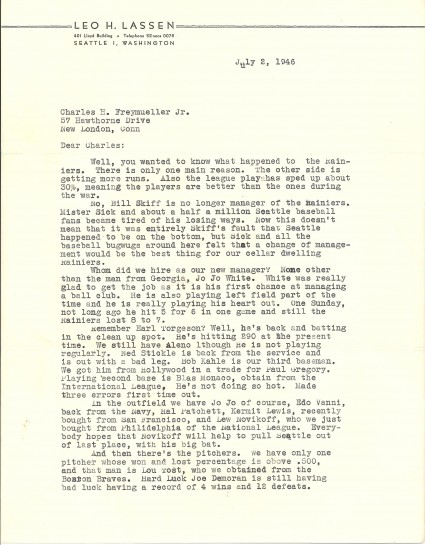
Indians owner Bill Klepper interviewed several applicants, apparently didnt like any of them, and called Lassen into his office and asked, Why not you? As Dan Raley reported in his history of the Seattle Rainiers, Pitchers of Beer, Klepper added, You know this game and you could talk a leg off a chair.
Had Klepper not been so cash strapped, a condition that forced him to sell the Indians to Rainiers Brewery owner Emil Sick late in 1937, he might not have even considered Lassen, who not only had no broadcasting experience, but owned a voice variously described as grating, metallic, “nasal, and monotone.
But Lassen got the job, almost instantly becoming the most recognized and imitated — voice in town.
“I went down to the station (KXA), sat down, and broadcast my first game. It was a road game, a re-creation,” Lassen told Post-Intelligencer sports columnist Royal Brougham in 1975. “From the first, it was natural for me.
Alone with his microphone and fertile imagination, and armed with the abbreviated information provided by Western Union (Lassens play-by-play data would have arrived to him via Morse Code), Lassen packed his accounts with phenomenal detail.
Instead of relying on sound effects, Lassen used his knowledge of baseball, familiarity with players, and his keen ability to visualize to describe every tug of a cap or wiggle of a bat.
If Leo said that Mike Hunt wiggled his bat 1-2-3-4-5 times, it might not have been exactly what Hunt had just done, but it was something Hunt had done enough times for Lassen to have clear mental image of it. Lassen had thousands of such images in his minds eye and used them to make listeners hang on every pitch.
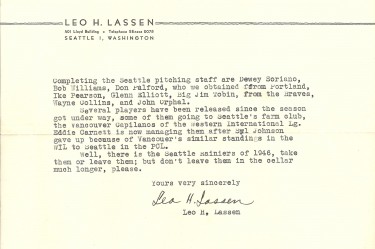
He mastered the art of re-creating drama, wrote Don Duncan of The Seattle Times in 1965, the umpire dusting off home plate, Jo Jo White taking a daring lead off first base, Bill Lawrence hitching up his pants. He did this from a bare teletype report and such was his skill that you couldnt tell the real from the ersatz.
In Lassens re-creations, he not only knew how to build to a climax, but when not to talk, as he explained to Duncan: Silence can be golden, Lassen told The Times man. Its like the white space between items in an advertisement. The listener has to visualize the batter coming up to the plate with his big bat. You have to give the listener that chance to visualize for himself.
Almost from his first night on the air, Leo was The Great Mouthpiece, Vince OKeefe wrote in The Times. On the occasions he received the barest of details from a telegraph operator — the batters name, the ball-strike count — his imagination would supply the rest. Many in his audience, this listener among them, actually thought, until they learned differently, that Leo was sitting in Seals Stadium (San Francisco) or Wrigley Field (Los Angeles), or wherever the Seattle team was playing.
If Lassen faced a Western Union technical delay, he might invent a few extra foul balls, but if it went on too long he would explain the issue to his audience and call for music to be played until the interruption ended.
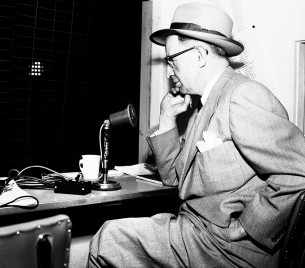
Belcher grew up in San Francisco listening to Bay Area sports announcers. He arrived in Seattle in the early 1950s and had a remarkable career covering a wide variety of sports, including the Rainiers and, later, the Seattle Pilots.
Leo was completely different from the San Francisco guys, said Belcher. But the audience grew to trust him. He never used a sound effect or did anything to speed up the game.
“Leo would never cut out a strike or a ball to make the game go faster. If a guy fouled off eight straight pitches, Leo would put them all in there.
As an illustration of Lassen’s attention to detail, when he attended home games, first at Dugdale Park, later at Civic Field, and finally at Sicks’ Stadium, he used a stopwatch to measure how many seconds it took a line drive, fly ball or popup to reach a fielders glove. During his re-creations, Lassen used the same timing, also with a stopwatch.
Lassens style became a major part of his allure. He had a rapid fire, almost staccato delivery that resonated with listeners once they got used to it, which took some doing. John Owen, who succeeded Royal Brougham as the Post-Intelligencers sports editor, wrote in a 1994 column that he could barely understand Lassen when he first heard him on the radio, but that once he understood what Lassen was saying, he could appreciate Lassen’s appeal and understand why Lassen had become an unforgettable part of the community fabric.
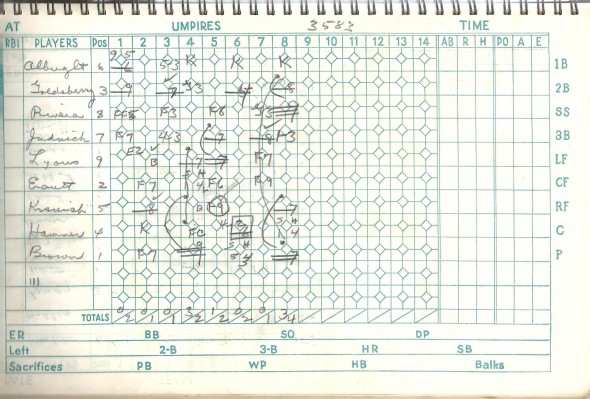
On summer evenings you could follow the progress of a game while walking through any residential area of Seattle, Owen wrote. Lassens voice projected from almost every open window or front porch.
You had to get used to him because he didnt have the usual smooth voice quality that you would hope for in a broadcaster, said Belcher.
Fans from eight to 80 amused themselves by trying to imitate his nasal twang, wrote OKeefe. In Seattle, more people could give you his back, back, back home run call than could intone Franklin Roosevelts My friends . . . ”
Lassens understanding of baseball rules rivaled that of managers and umpires He could recite that rule book off the top of his head, from memory, said Belcher — but he explained complexities in a way listeners could appreciate and understand.
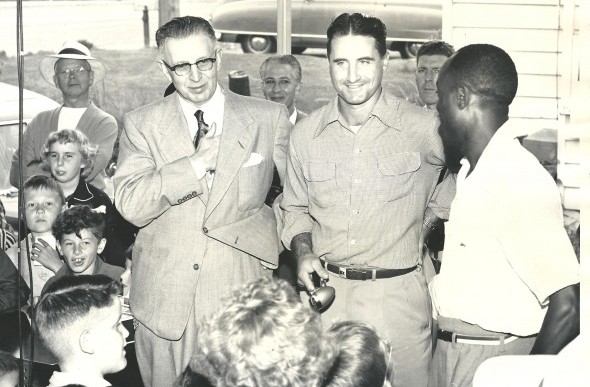
One Seattle Times reader told the newspaper that Lassens explanation of the infield-fly rule was so good, even my wife understands it.
After Lassen died, Brougham wrote that Lassen had created an entire dictionary of baseball terms. A “dictionary” might be a stretch, but he had many, and Leos Lassenisms further endeared him to his audience.
- “Back . . . back . . . back . . . and it’s over!” (home run call)
- “Three city blocks and two country miles over the left-field wall! Boy, did he hit that one!” (extra-long home run)
- Roses are red, violets are blue, Barrett is pitching, three and two!
- Oh, baby, that was closer than the next second!”
- It was a do or ya dont and he did (or he didnt).
- Hang on to your rocking chairs!
- “That play at first was closer than wallpaper!”
- “There goes Becker, and he’s no gazelle!”
- Mount Rainier is out and looming behind Franklin High School like a big ice cream cone.
- “This one’s in the well” (Rainiers win)
It was a precise voice, a creative voice, wrote Duncan, making little phrases a part of everyday household vocabulary.
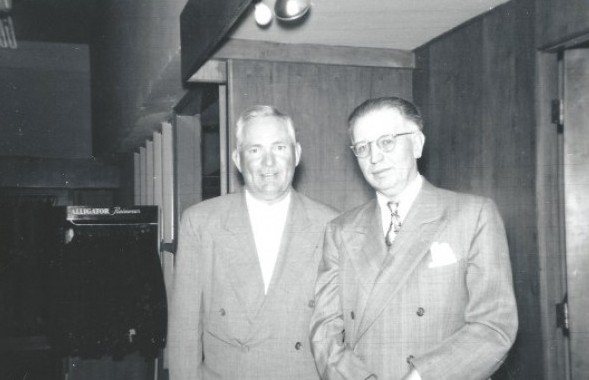
He had all of these idiosyncratic phrases that he would use and people loved them, Belcher said. On a close play, hes say, Here it comes! He beat the ball! He beat the ball! There were hundreds of those things. For a few years, he had alliterative descriptions of the players, I think for everyone on the team. Hed say, Earl Rapp raps one! or Sheridan shillelaghs it!
Youngsters imitated his pet phrases, wrote Torchy Torrance, who served two decades as the Rainiers executive vice-president. He was an encyclopedia of baseball facts and his memory of baseball lore was phenomenal. His dramatic broadcasts helped the Rainiers set attendance records because he created interest and always urged his legion of listeners to go to the ballpark whenever they could.
Lassen, who broadcast hockey and Husky basketball during winters, had a couple of opportunities to work in the major leagues, notably with the Chicago White Sox. Asked once by the Sox to travel to the Windy City for an audition, Lassen declined with this explanation: The trees are tall here and my roots are deep.
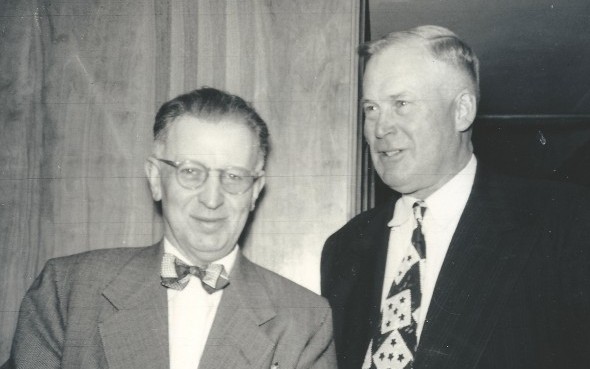
As good as Lassen was at calling and re-creating games, he was equally adept at pitching products. He wove his sales spiels seamlessly into his game commentary, advising youngsters to Make sure and eat your Wheaties with milk and sliced fruit, and tossing out such calls as Hes as safe as a Silvertown Tire!
There is no journalist today like Leo Lassen. In addition to broadcasting every Indians/Rainier game, for many years he also wrote the team’s game accounts for The Post-Intelligencer, employing a straight-foward style that accurately summarized events, but conveyed little of his personality, which is what his radio audience craved.
It seems that his community-wide appeal came down to the fact that Leo’s fans loved listening to the bespectacled bachelors love affair with baseball as much as they loved the Rainiers themselves.
Lassen rose to city-wide popularity after Sick purchased the Indians from Klepper, re-named them the Rainiers, moved them into his namesake ballpark and introduced a succession of highly popular Fred Hutchinson and Edo Vanni, to name two players who succeeded in winning three consecutive (1939-41) PCL pennants.
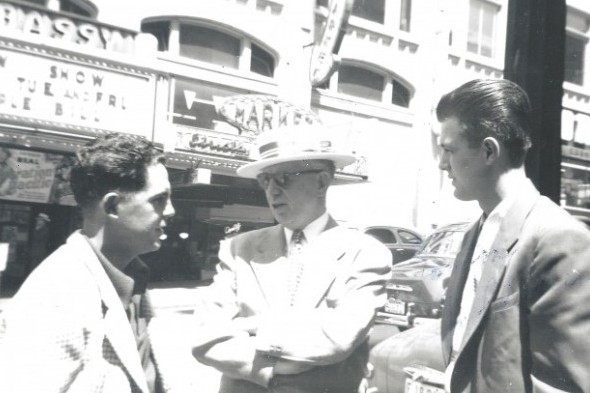
Although Sick saved baseball in Seattle through his financial intervention, it was Lassen who reflected the clubs identity. Through Lassen, fans bonded with the likes of Jo Jo White, Bill Lawrence, Dick Gyselman, Kewpie Dick Barrett and Hal Turpin, but also bonded with Lassen.
He became Mr. Baseball, The Great Gabbo and The Voice, but more important, Lassen succeeded in making himself a member of every baseball-loving family in Seattle. According to those who remember him, he might as well have been the only Leo in the whole place.
He was more familiar to Seattle radio listeners than Ma Perkins, Amos n Andy, Myrt and Marge and the whole cast of I Love a Mystery put together, Duncan wrote.
Opined Brougham in 1975: “It was bad etiquette to telephone a friend between the hours of eight and 10 p.m., the caller being informed — Call later, Leo is on the air. ”
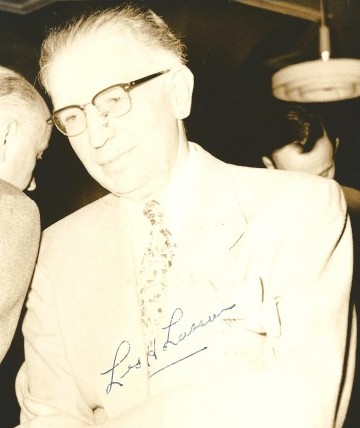
Few of his listeners knew Lassen on a personal level. Famously shy, single and introverted, he lived with his infirm mother in Wallingford in a house located in the 6700 block of Latonia Avenue. He had no other family and few, if any, friends.
He was a good guy, but an odd guy, recalled Bill Sears, who toiled as a Rainiers publicist for many years.
For most of Lassens run (1931-1960), he had almost no competition for an audience until television came along, a development that greatly hastened his exit from the airwaves. In 1955, for the first time, KVTW televised all Rainiers home games, which meant that Lassen was no longer a fans sole connection to the ball club.
Following the 1956 season, a year in which the Rainiers held Leo Lassen Night at Sicks Stadium (Lassen received numerous gifts including a new Chevrolet), KOL purchased broadcast rights to Rainiers games and station management concluded Lassen had become outdated.
But instead of firing the icon, the station, in recognition of his years of service, offered to pay him during the baseball season, but at a salary roughly half of what he had previously earned. Wounded, Lassen rejected KOLs offer and quit just before the 1957 season.
When they broke his contract, they also broke Leos hart, Torrance wrote.
Belcher, who had re-created major league games for several years, sometimes as many as 200 per season, accepted the no-win task of following Lassen to the microphone.
I was just glad to have a job and do my own thing, said Belcher. I would even throw in a little Lassen phraseology in spite of myself. But people who listened to him for years wouldnt cotton to anybody who succeeded him (one of the reasons the Mariners haven’t replaced Dave Niehaus).”
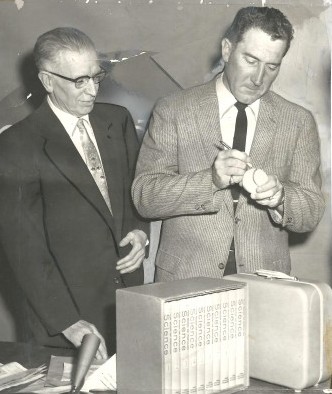
After a change of sponsors (broadcasters were usually employed by sponsors), Lassen returned for the 1959 and 1960 seasons after Sick sold the Rainiers to the Boston Red Sox and the Rainiers broadcast rights went to KOMO.
Following the 1960 season, Lassen became embroiled in another contract dispute with the new owners and, insulted by a lowball offer to return in 1961, quit this time for good. According to the Rainiers, Lassen broadcast more than 5,000 games, half of them re-creations, the toughest of which, according to Lassen, occurred in 1950.
That year, Lassen told Duncan, Seattle pitcher Jim Wilson went up against the Hollywood Stars in a bid to tie the Pacific Coast League record with 16 consecutive pitching victories first set in 1909 by Frank Browning.
Must have been a million people tuned in, Lassen told Duncan. They had game delays and I finally caught up with the wire. Mike Rhodes, my assistant, was flashing hand signals of the action through the (studio) window that separated me from the telegraph machine. There wasnt time to run the balls and strikes over to me. Wilson lost 4-3 when a ninth-inning bunt blooped over his head as he charged the plate to field it. That was the only time I ever finished a game exhausted. I was a wreck.
A telegraph operator once told Leo that it was eerie to sign off, leave the ball park, tune in his car radio to a Seattle station and find Leo broadcasting the ninth inning.
Leo, I didnt tell you all those things on the wire, the telegraph operator told him.
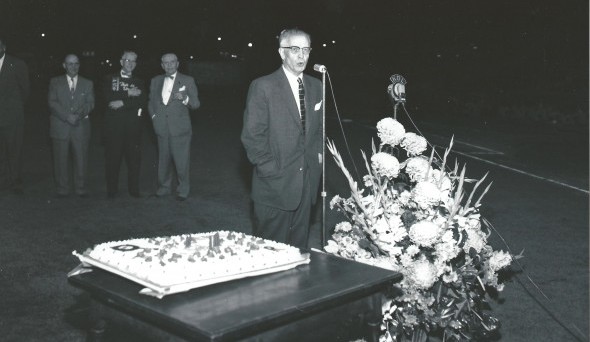
Lassen never attended another baseball game, at least not another Rainiers game, and never, according to a 1973 Lenny Anderson interview, again stepped inside Sicks Stadium. He also largely abandoned the company of his media mates, with whom he enjoyed sharing a libation, particularly at The Grove on Sixth and Wall, just across the street from the old Post-Intelligencer plant.
Lassen was an appreciative but not a compulsive drinker, wrote Seattle columnist Emmett Watson, who socialized with him. He didnt drink often, but when he stalked Old Crow it became an endangered species.
A life-long bachelor, Lassen had been a frequent public speaker and quite the man around town during his broadcasting heyday. But once he walked away from the Rainiers, he spent the remainder of his years in seclusion in the same, two-story fame Latonia house he had occupied since 1925, caring for his mother until her death in 1968 at age 98.
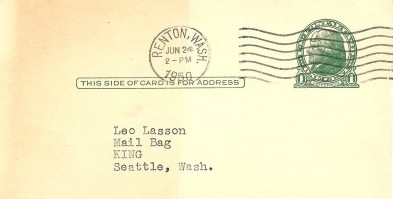
Lassen busied himself with his prize rose garden, by reading histories and plays, listening to classical music, and playing with his peppy little mongrel, Danny.
Leo brings the same attention to detail to flowers, books and classical records as he did to baseball, Duncan wrote after Lassen retired. He prunes his roses with tender care and can reel off names and blooming habits of scores of varieties.
He loved classical music and could play and compose on the piano despite his handicap (crooked arm), Torrance wrote. Then one day when his mother went down to the basement to get their laundry, she slipped and fell and broke her hip. She died several months later, and Leo was really alone after that. He had a lot to offer, but he just hibernated.
“Once he quit broadcasting, I don’t think I ever saw him again,” said Belcher. “He became a total recluse.”
In 1975, Lassen underwent a series of visits to Ballard Community Hospital to treat lung congestion. When the end came, Dec. 5, at age 76, just as construction workers were putting the finishing touches on the Kingdome, Brougham wrote, Leo Lassen died in the dark hours of early morning, alone in his hospital room.
“A lonely man, he has no living relatives, and only a handful of close friends. But the pioneer broadcaster of the Seattle Rainiers had tens of thousands of admirers who knew him only as a voice.”
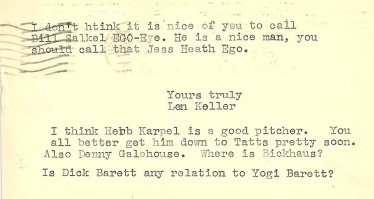
Three of those admirers, Don Klein, Bud Foster and Tony Koester, became legendary PCL announcers themselves, Klein with the San Francisco Seals, Foster with the Oakland Oaks/Acons and Koester with the Sacramento Solons.
Klein grew up in Seattle listening to Lassen. After a stint in the Navy during World War II, he moved to Hawaii and persuaded a Honolulu radio station to allow him to do re-creations of PCL games.
He did the re-creations so well that in 1949 Seals owner Paul Fagan hired him to broadcast his team’s games. Klein continued with the team until it folded after the 1957 season, broadcast Stanford and San Francisco 49ers football for four decades, and entered the Bay Area Sports Hall of Fame in 2008.
Born in Seattle, Foster grew up with ambitions of becoming a third baseman and even had a tryout with the Indians in 1932, when he first met Lassen. Foster didn’t stick and entered the radio business, first in Alaska.
NBC hired Foster as a War Correspondent from 1943-45, after which he took the Oakland baseball job. He entered the Bay Area Radio Hall of Fame in 2007.
Born in Rock Island, IL., Koester graduated from the University of Washington with a degree in journalism and launched his radio career by doing high school sports in Wenatchee, WA.
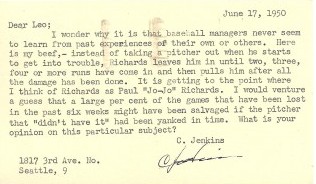
He went on to broadcast games for the Wenatchee Chiefs of the Western International League and joined the Solons in 1938. Koester became famous in Sacramento for his re-creations, and for one week each year he re-created games in a downtown storefront window.
Tough to know whether Lassen would have approved of his proteges. Lassen, who once told Duncan, Baseball is the greatest sport ever devised by man, believed that he was the man best suited to broadcast it.
He was one of a kind and he did not imitate anybody, said Belcher. He developed his own style, people got used to it and considered him the ultimate authority. He considered himself the ultimate authority, and maybe he was. He could quote the rule book and he would often describe all kinds of possible plays where a real knowledge of the rules pertained.
Lassen was fun to listen to. But he didnt think any other broadcaster was any good, including me. He thought they were all terrible, even the major league announcers, because they didnt know the game like he did. He thought of himself as the ultimate expert. But he was a good guy, kind of a strange guy, but fun to talk to.
A letter to The Times from Father Bob Rebhahn, Society of Jesus, following Lassen’s death, summed up how Lassens listeners felt: Leos voice was a part of my life from 1931 on. I never met the man or even saw him, yet he was like a close friend.
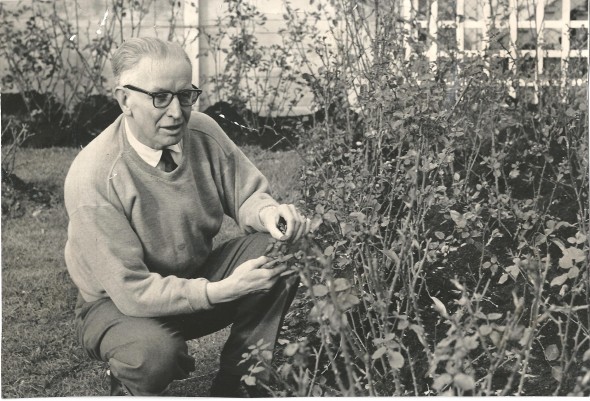
Inducted into the State of Washington Hall of Fame in 1974, a year before his death, Lassen is inurned at Washelli Columbarium at Evergreen Washelli Memorial Park.
In 2001, on Seattles 150th birthday, The Times published a list titled 150 People Who Shaped Seattle. The individuals on that list included our demi-gods of industry, politics, media, education and the arts . . . Allen . . . Bagley . . . Bartell . . . Bauer . . . Beck . . . Benaroya . . . Boeing . . . Bullitt . . . Carkeek . . . Chittenden . . . Cornish . . . Denny . . . Ellis . . . Fisher . . . Gates . . . Green . . . Haglund . . . Hendrix . . . Horton . . . Magnuson . . . Maynard . . . Meany . . . Mercer . . . Nordstrom . . . Piggot . . . Rosellini . . . Skinner . . . Speidel . . . Suzzalo . . . Whitaker.
Only one man of the list talked about minor league baseball for a living, Leo Lassen.
Writing about Lassen in the wake of his death, OKeefe said, Lassen signed off each broadcast with, Uh, this is Leo Lassen speaking. I hope you enjoyed it. We did Leo, thousands upon thousands of us.
Since Lassens broadcasts occurred before tape, his words have disappeared. But the memory of them is still powerful. Asked about Lassen now, nearly 40 years after his death, Belcher says, I still have not listened to anybody like him.
A listener asked Leo Lassen to provide a copy of star pitcher’s Fred Hutchinson’s 1938 pitching record with the Seattle Rainiers and this, replete with Lassen’s handwritten notes, is what he provided. / David Eskenazi Collection
————————————————-
Many of the historic images published on Sportspress Northwest are provided by resident Northwest sports history aficionado David Eskenazi. Check out Davids Wayback Machine Archive. David can be reached at (206) 441-1900, or at seattlesportshistory@gmail.com

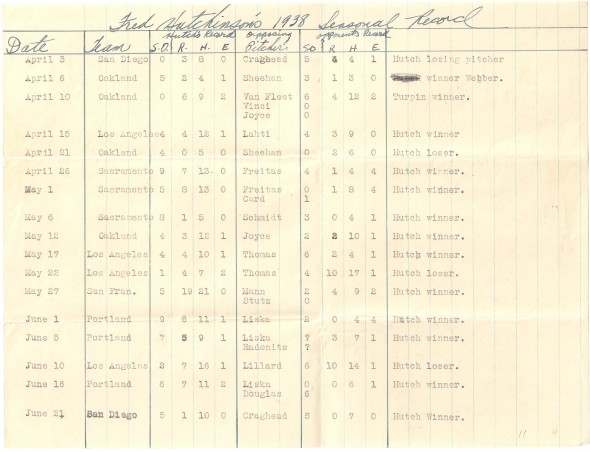
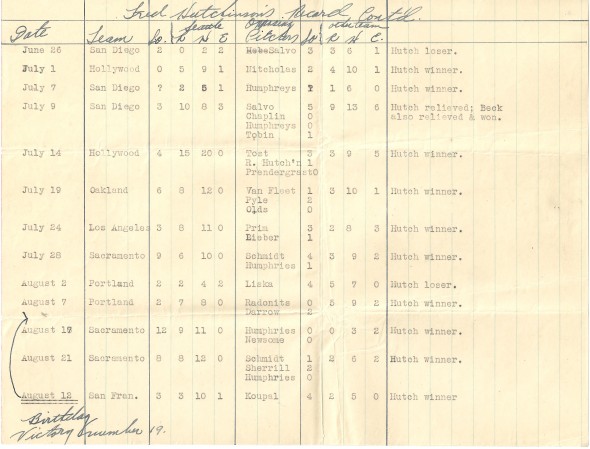
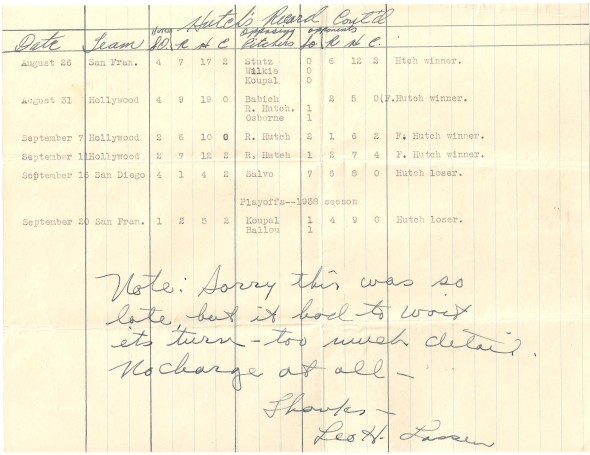
11 Comments
Thanks, fellas, for another gem. Leo Lassen was an important part of the daily lives of many thousands of Puget Sound-area kids who followed his broadcasts religiously—-just as important in his time as Dave Niehaus would become later. We especially valued his daily five-minute, pre-game shows discussing inside baseball and how to play the game. “Back, back, back…and it’s over!” was his homerun call.
I listened to his broadcasts up in Bellingham. When I wanted to hear a live broadcast, rather than a re-creation, of Rainier games I would tune in to Tony Koester at KFBK in Sacramento, sponsored by
Sunbeam Bread, and Rollie Truitt in Portland when the Rainiers played there. The KFBK signal was especially strong, and came in clear at night, whereas reception from Portland was spotty. I
attended with my parents a Rainier game at the old Vaughn St. Park in Portland and enjoyed it immensely. It was just as Leo had described it.
Have enjoyed your columns over the years. Thanks for the response.
Thanks, fellas, for another gem. Leo Lassen was an important part of the daily lives of many thousands of Puget Sound-area kids who followed his broadcasts religiously—-just as important in his time as Dave Niehaus would become later. We especially valued his daily five-minute, pre-game shows discussing inside baseball and how to play the game. “Back, back, back…and it’s over!” was his homerun call.
I listened to his broadcasts up in Bellingham. When I wanted to hear a live broadcast, rather than a re-creation, of Rainier games I would tune in to Tony Koester at KFBK in Sacramento, sponsored by
Sunbeam Bread, and Rollie Truitt in Portland when the Rainiers played there. The KFBK signal was especially strong, and came in clear at night, whereas reception from Portland was spotty. I
attended with my parents a Rainier game at the old Vaughn St. Park in Portland and enjoyed it immensely. It was just as Leo had described it.
Have enjoyed your columns over the years. Thanks for the response.
The last car my grandpa drove (this would’ve been the late 60’s/early 70’s) was some 50’s-era boat he bought from Leo. That thing could’ve dented the Kalakala. Everyone in the family knew him because he’d often eat dinner at their home in Mount Baker before he and Grandpa left for the ballpark together. The unanimous opinion was that Leo was a pretty good guy, a loner who followed the beat of his own drum.
On radio, Leo was absolutely a legend in his time the way Dave Niehaus is today. Wayne Cody spent part of a program devoted to Leo when he was on KTW with Edo Vanni and others and parts of that show were turned into a tribute record album in the mid 70’s. One side has recordings from two games from the late 40’s or early 50’s. Worth tracking down on eBay (or maybe the Goodwill on Dearborn, where I’ve seen copies in the record bins). About 10-15 years ago, when I was hosting a short-lived sports talk show, I did one as a tribute to Leo that included a “fantasy interview” in which I asked questions of Leo and he “answered” via clips of an (obviously) earlier interview that were included on the album. Kinda hokey, but it more or less worked. Still have a cassette of that show somewhere.
Good stuff as always, Dave and Steve, and good comment below, Ted. People who credit the “back-back-back” call to Chris Berman have no idea that Berman was about 40 years behind the guy who really initiated it.
Thanks to you for weighing in. Appreciate it, as always.
The last car my grandpa drove (this would’ve been the late 60’s/early 70’s) was some 50’s-era boat he bought from Leo. That thing could’ve dented the Kalakala. Everyone in the family knew him because he’d often eat dinner at their home in Mount Baker before he and Grandpa left for the ballpark together. The unanimous opinion was that Leo was a pretty good guy, a loner who followed the beat of his own drum.
On radio, Leo was absolutely a legend in his time the way Dave Niehaus is today. Wayne Cody spent part of a program devoted to Leo when he was on KTW with Edo Vanni and others and parts of that show were turned into a tribute record album in the mid 70’s. One side has recordings from two games from the late 40’s or early 50’s. Worth tracking down on eBay (or maybe the Goodwill on Dearborn, where I’ve seen copies in the record bins). About 10-15 years ago, when I was hosting a short-lived sports talk show, I did one as a tribute to Leo that included a “fantasy interview” in which I asked questions of Leo and he “answered” via clips of an (obviously) earlier interview that were included on the album. Kinda hokey, but it more or less worked. Still have a cassette of that show somewhere.
Good stuff as always, Dave and Steve, and good comment, Ted. People who credit the “back-back-back” call to Chris Berman have no idea that Berman was about 40 years behind the guy who really initiated it.
Thanks to you for weighing in. Appreciate it, as always.
I never had the privilege to hear Leo but feel I now understand why Seattle loved him thanks to this wonderful article. Thank you. – Nelson Murray
I never had the privilege to hear Leo but feel I now understand why Seattle loved him thanks to this wonderful article. Thank you. – Nelson Murray
I came across this wonderful article just now. Loved it. There was a record produced a number of years ago about Leo Lassen, which contained excerpts of his broadcasts. For the life of me I can’t remember the title of it. Through that record I was able to hear his work, and it was just as it is described here. I would like to add that when the Western League Seattle Americans Hockey Club was sold to a group of Seattle-area businessmen and civic leaders in 1958, Lassen was a member of that group. The team then became the Seattle Totems and went onto great success in the late 50s and 1960s.
It’s so nice to now know something about the man beyond the broadcaster. Thank you.